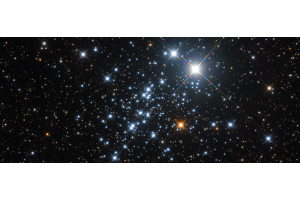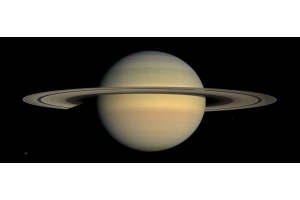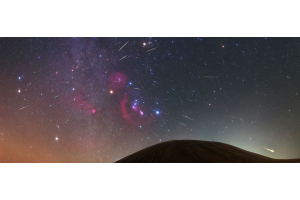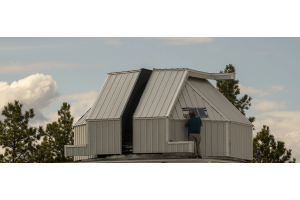
In this episode of What's in the Sky this Month, Teagan reviews some of the beautiful celestial objects you can see in the month of October!

Image credit: NASA/ESA
Messier 52
Draw a line through Shedar and Caph in Cassiopeia toward Alderamin in Perseus, and about a quarter of the way there, you might stumble across Messier 52. If you have transparent, dark skies, you may be able to spot the cluster with binoculars, but otherwise, it’s best to use a scope.
At a low magnification of 35x, you’ll easily see the orange star 4 Cassiopeiae within the same field of view. The cluster itself appears compact and conical, with a bright star at the tip and a base that’s brighter than the rest of the cluster.
Using averted vision reveals more stars, especially when the magnification is increased to around 100x. In particular, look out for several yellow stars that provide a nice contrast with their blue-white companions.
OUR NEAREST NEIGHBORS
Venus continues to be an easy target after sunset. A crescent Moon hangs to its lower left on the 5th before the planet passes Antares in Scorpius on the 25th. If you have a clear view of the southwestern horizon, you may also be able to spot Mercury very low in the twilight during the last days of the month. Saturn can be seen rising in the southeast in the evening, with a gibbous Moon to its left on the 14th. Neptune is in a similar position and should be telescopically observable from about 9 PM onwards. Uranus rises mid-evening but is best observed closer to midnight. It remains within the same binocular field of view as the Pleiades all month - literally a once-in-a-lifetime opportunity to see the two together. Similarly, Jupiter rises late in the evening and is best seen after midnight among the eastern stars of Taurus. A waning gibbous Moon appears to its upper left on the morning of the 21st. Meanwhile, Mars is also visible in the morning sky and is passing Castor and Pollux in Gemini, with the last quarter Moon close to all three on the 23rd. Lastly, the Moon turns new on the 2nd, and then the Full Hunter’s Moon occurs on the 17th.

Image credit: NASA, ESA, and A. Hajian
NGC 7662 - The Blue Snowball Nebula
The Blue Snowball is a fine example of how planetary nebulae got their name. A magnification of just under 100x shows a small, circular, slightly blue disc - much like a planet. Increasing the magnification to over 200x will show rings of blue and green surrounding the darker center.

Image credit: Guillaume Seigneuret
NGC 7789 - Caroline’s Rose
Found within the same binocular field of view as Caph (Beta Cassiopeiae), small telescopes show it as a rich and concentrated patch of faint stars with no discernable core, while a mid-sized scope shows a band of stars encircling the center.
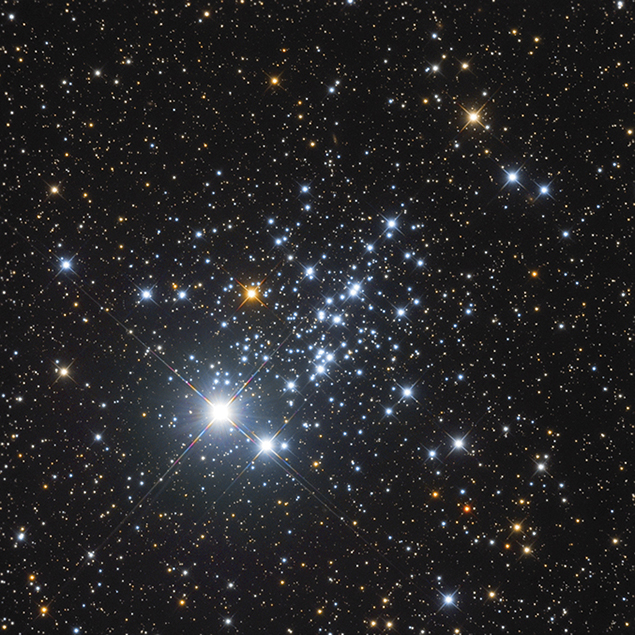
Image credit: Leonardo Orazi
NGC 457 - The Owl Cluster
Another Cassiopeia star cluster, NGC 457, lies close to Ruchbah and is a wonderful target for small telescopes. A low magnification of around 30x will show Phi Cassiopeiae, the double star that marks the owl’s eyes. The rest of the stars outline its body and outstretched wings, with the densest portion of the cluster appearing in the owl’s chest area.

Image credit: David Ritter
Eta Cassiopeiae - Achird
Look between Shedar and Gamma Cassiopeiae, and you’ll find Achird, an easy double star for small scopes. A magnification of around 50x will split the star into its white and coppery red components.
STELLAR CONCEPTS
New General Catalog (NGC): Amateur astronomers use several catalogs of deep sky objects, with one of the most frequently used being the New General Catalog (NGC). Compiled in 1888, it is primarily based on observations by the Herschel family and contains nearly 7,900 objects. The vast majority of these are galaxies; of the rest, 495 are open star clusters, 247 are diffuse nebulae, 133 are globular star clusters, and 96 are planetary nebulae.







